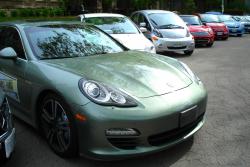 Click image to enlarge |
Article and photos by Michael Schlee
Photo Gallery:
AJAC Eco Run – The Cars
AJAC Eco Run – The Cars
It is all over. After 3 days and roughly 350 km of driving, all 23 vehicles of the inaugural Automobile Journalists Association of Canada (AJAC) Eco-Run, in association with CAA, Natural Resources Canada and Schneider Electric, made it to the finish line. Well, one car had to be flatbedded for a leg as its key went missing, and one of the electric vehicles ran out of battery power on the final leg as the driver got lost and more than doubled the planned distance of that final leg. But all in all, it was a successful journey that proved that when it comes to obtaining maximum fuel efficiency, it is as much about the driver as it is the vehicle.
The AJAC Eco-Run is an event aimed at demonstrating and educating the public on several advancements in advanced fuel-saving technologies. However, by the end of the three-day journey, I think I received my own fair share of education and insight. The goal of the event was to demonstrate fuel-efficient driving techniques, showcase the latest fuel saving technology available on vehicles for sale in Canada today, and highlight how important educational institutions across Canada are to the continued development of sustainable resources.
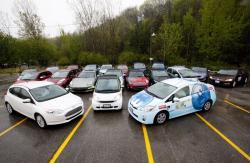 Click image to enlarge |
We, as the Eco-Run drivers, were challenged to achieve the best mileage possible without exaggerated hypermiling in the vehicles assigned to us. We were tasked with demonstrating that with a few simple adjustments to our driving habits, you can achieve the fuel economy figures published by Natural Resources Canada (NRCan). Of the seven vehicles I drove, I was able to meet or exceed the combined fuel economy ratings for five of the vehicles from NRCan, but I will cover the vehicles themselves in greater detail in a separate article to be published later this week.
So why would we do this demonstration now, and why in Canada? Well, as one of the corporate sponsors, CAA, noted, Canada has a ratio of roughly two people per single car nationwide, which is one of the highest ratios in the world. Although we are a small nation population-wise, we are more dependent on the automobile than more populous countries and thus, need to be at the forefront of sustainable fuel sources and sustainable living initiatives. As a lifetime resident of southern Ontario, I was surprised at how much work is being done in our own backyard and was pleasantly surprised at the state-of-the-art institutions working on a cleaner future for all of us.
Day 1
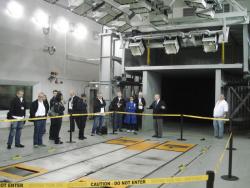 Click image to enlarge |
We started our journey on a rainy morning in Brighton, Ontario. Luckily the start took place inside a hockey arena and we were kept dry for the opening ceremonies. We headed west and took our first stop at the CAA office on Cobourg, Ontario. The first leg, although rainy, was fairly straightforward and flat.
From Cobourg we continued west to Oshawa where we stopped at the impressive University of Ontario Institute of Technology. I have a bit of a confession to make. I did not know much about this facility before the run. However, having now toured it, I am blown away at the advanced equipment and research available from this facility. Without going into too much detail, the UOIT features four key research chambers: the climatic wind tunnel, climate chambers, climatic four-post shaker, and a multi-axis shaker table (one of few available in Canada).
The highlight is the climatic wind tunnel. It is fully adjustable and can accommodate anything from a motorcycle to a double decker bus. The wind chute opening is adjustable and the vehicle is placed on a rotation table capable of testing crosswinds and three-quarter winds. Wind speeds can exceed 240 km/h and temperatures can range from -40C to 60C. Humidity and solar heat can also be adjusted. UOIT representatives claim it is the most sophisticated thermal-climate-controlled wind tunnel in the world.
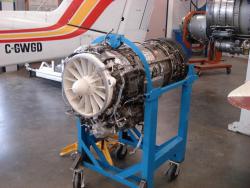 Click image to enlarge |
From UOIT it was back on the road to our final stop of Day 1, Centennial College in Toronto. Being a GTA dweller for 27 of my 31 years, I have always known of Centennial College, and passed by it more times than I can count. However, I had never been inside it until this past week and what an eye-opening experience it was. Short of railroad trains, if it is a form of transportation, Centennial College educates students on it (with full-scale real life examples). Centennial focuses its programs on practical training and issues surrounding sustainable living for the future. The programs cover everything: heavy duty trucks, heavy equipment, aviation, marine, motorcycles, automobiles, etc. Their goal is to create the best of the best for future workforces. They are also conscious of the environment and employ eco-friendly practices like using virtual painting processes to save on paint and lower chemical exposure to both people and the surrounding environment.
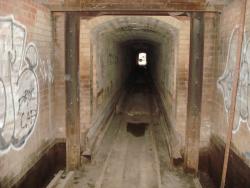 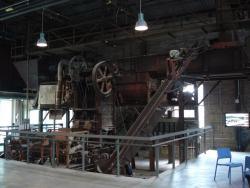 At the former Evergreen Brickworks site. Click image to enlarge |
Day 2
We began our second day back at Centennial College. After a brief press conference we headed southwest to the Evergreen Brickworks in Toronto. For anyone in the Toronto area who hasn’t visited this establishment on Bayview Avenue, I highly recommend it. The Evergreen Brickworks is about urban sustainability for everything from food to transportation. This facility was developed from the relics of 100-year-old brickwork manufacturing buildings. The brick-making company that used to occupy the land shut its doors in 1983 as the clay integral to making bricks was located too deep in the nearby pit to be excavated. The location was abandoned for 25 years (minus the odd rave party) and was reopened a few years ago with the goal of making an environmental community centre. The 130-foot clay pit that was excavated to produce the bricks was filled with water and is now a pond/ravine surrounded by nature trails. Additionally, the Evergreen Brickworks is home to a nursery, outdoor skating arena, bicycle training course, outdoor children’s play-shop, boutique stores, a restaurant, trails, and much more with further additions on the horizon.
From the Evergreen Brickworks we embarked on the most grueling stretch of the entire AJAC Eco-Run. We drove from East Toronto clear across the heart of the GTA to Oakville, Ontario, travelling exclusively on Dundas Street. This took us through Downtown Toronto, Etobicoke, Mississauga, and eventually Oakville. To get an idea of how this rain-soaked drive went, over the 42.6 km trek I averaged 20 km/h and took over 2 hours to arrive at the CAA office in Oakville, Ontario. Needless to say, no one was eager to jump back into the vehicles and try that leg of the journey again. Luckily, our last jaunt of the day was a fairly quick one to McMaster University in Hamilton, Ontario, where our vehicles would rest and recharge for the night.
Day 3
 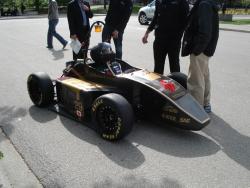 McMaster University. Click image to enlarge |
The final day of our journey began back at McMaster University. McMaster has an in-depth automotive program called MacAUTO. They are tackling the issue of “what’s next?” for both the electric energy industry and the automotive industry. MacAUTO is focused on transportation electrification and solutions like the smart grid. They claim to have the highest amount of interest amongst all colleges and universities in North America on the topic of transportation electrification.
From McMaster we headed west on what seemed to be an endless uphill, albeit scenic, route to Woodstock, Ontario. Aside from the marathon drive across Dundas Street, this was the most challenging drive from an efficiency standpoint. Once in Woodstock, we were greeted by a surprisingly large turnout despite the high winds. After our press conference and lunch, we were back on the road to Fanshawe College in London.
It was on this final stretch that many vehicles achieved their best fuel economy numbers of the week. The 2012 Lexus CT200h achieved an amazing 3.7 L/100 km, the 2012 Chevrolet Cruze clocked in at 4.4 L/100 km, the 2012 Mercedes-Benz CLS 63 AMG was driven to 9.7 L/100 km and yours truly achieved 5.6 L/100 km in the FWD 2013 Mazda CX-5 GS.
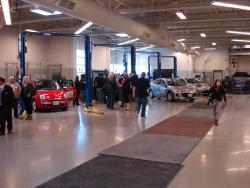 Fanshawe College. Click image to enlarge |
After the Eco-Run closing ceremonies we were given a tour of the new transportation facilities at Fanshawe College. Like Centennial College, Fanshawe is involved in every aspect of the transportation industry minus railway trains. Everything from auto body repair to aviation structural technician to farm equipment mechanicals is taught at the college. In keeping with the environmental theme of the Eco-Run, many “Going Green” initiatives have been implemented at Fanshawe, such as a green roof, storm water reclamation, solar-powered GPS-tracking skylights, and solar hot water preheating.
By the time we left Fanshawe College, many of us were exhausted, but in a good way; like after an exhilarating hike through a mountain trail on a warm spring day. The knowledge I gained and facilities we visited really opened my eyes on how much focus and attention there really is on achieving sustainable living in not just the distant future but also the near future. The future looks bright, and I’d also wager it’s going to be a lot cleaner and healthier.











